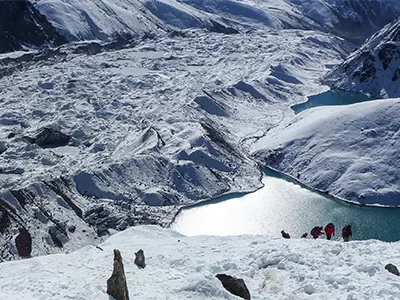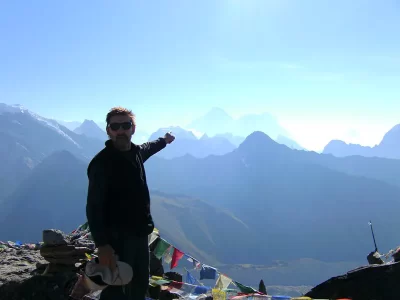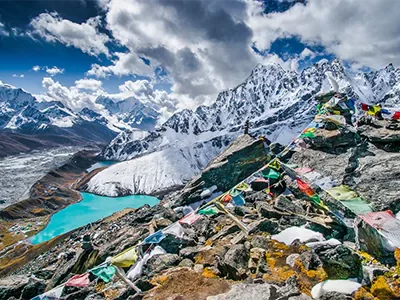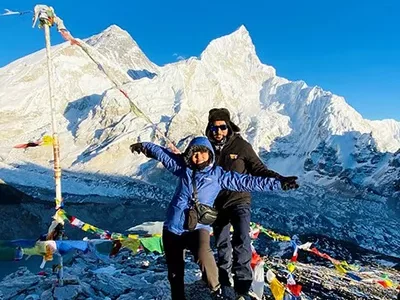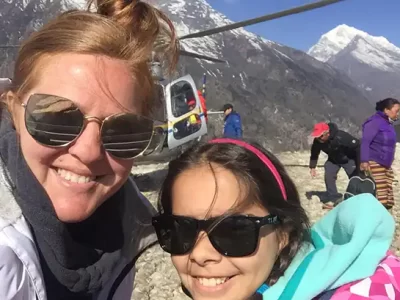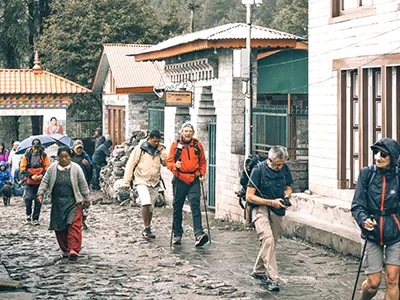Gokyo Lake is an alpine gem in Nepal’s Everest region. At around 4,750 meters, it’s one of the world’s highest freshwater lakes. The lake’s turquoise waters, framed by towering snow-capped peaks, create a mesmerizing scene that draws trekkers from all over the world.
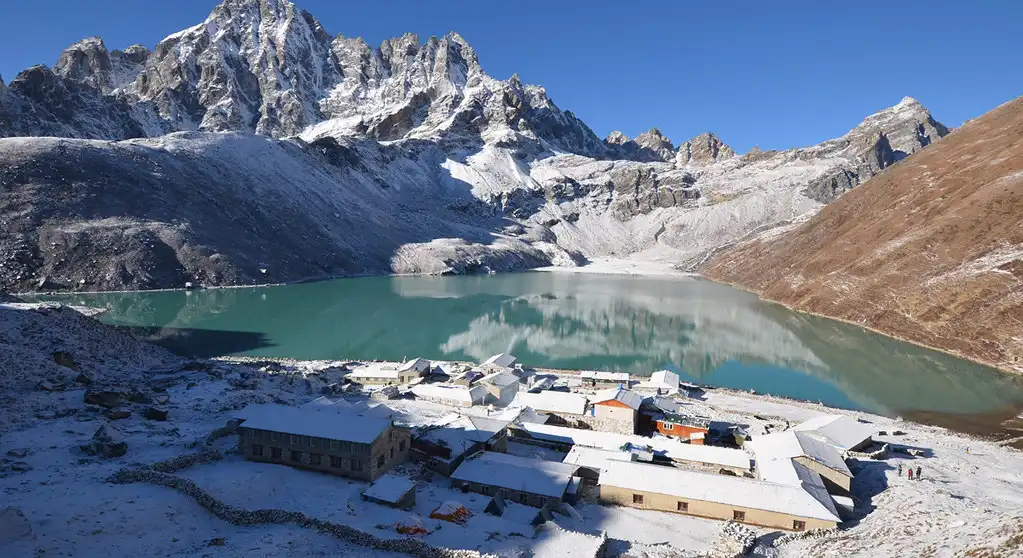
The Gokyo Lakes Trek offers breathtaking views and a unique trail that blends adventure with natural beauty. A key highlight is the ascent to Gokyo Ri, which reaches 5,357 meters. From its summit, trekkers enjoy panoramic vistas of Everest, Lhotse, Makalu, and Cho Oyu.
Highlights
- Gokyo Ri Summit: Enjoy panoramic views of Everest and the surrounding peaks from the top.
- Turquoise Lakes: Admire the five pristine Gokyo Lakes against the stunning Himalayan backdrop.
- Cho La Pass: Cross this high-altitude pass, connecting Gokyo with the Everest Base Camp trail.
- Ngozumpa Glacier: Explore one of the Himalayas’ longest glaciers.
- Flora and Fauna: Discover unique wildlife and diverse alpine vegetation on your trek.
- Renjo La Pass: Take in spectacular views of Everest and other giants from this scenic pass.
- Sherpa Culture: Experience the rich culture of the Sherpa people in local villages and monasteries.
Many combine this trek with the Everest Base Camp and Gokyo Lakes Trek, creating an extended trek that covers both iconic routes. The Everest Base, Camp Gokyo Lakes Trek, takes an alternative path that includes the challenging Cho La Pass.
On the Gokyo Lakes Everest Base Camp route, trekkers experience diverse landscapes and cultural encounters. The Gokyo Ri view is particularly striking, offering an unparalleled perspective of the Himalayan giants.
Those combining their trek with a visit to Everest Base Camp via Gokyo Lakes find a less crowded and more scenic route. The Everest Gokyo Lake trek is about more than just reaching the destination; it’s about the trek itself, filled with awe-inspiring views and enriching experiences.
Gokyo Lakes Trek
Gokyo Renjo La Pass Trek
Gokyo Cho La Pass Trek
How to Get to Gokyo Lakes from Kathmandu
If your trip starts in Kathmandu and you are wondering how to get to Lake Gokyo from there, don’t worry; There are many ways to get around. You can reach Lake Gokyo from Kathmandu via two air routes and one land route.
1. Flight from Kathmandu to Lukla and Trek to Gokyo Ri
Start your Himalayan adventure with a flight from Kathmandu to Lukla (2,800 meters/9,186 feet) to Lake Gokyo. The flight from Kathmandu to Lukla in the morning takes about 40 minutes. This flight takes you to the gates of the Everest region, where you join the Gokyo Lake Hiking Trail.
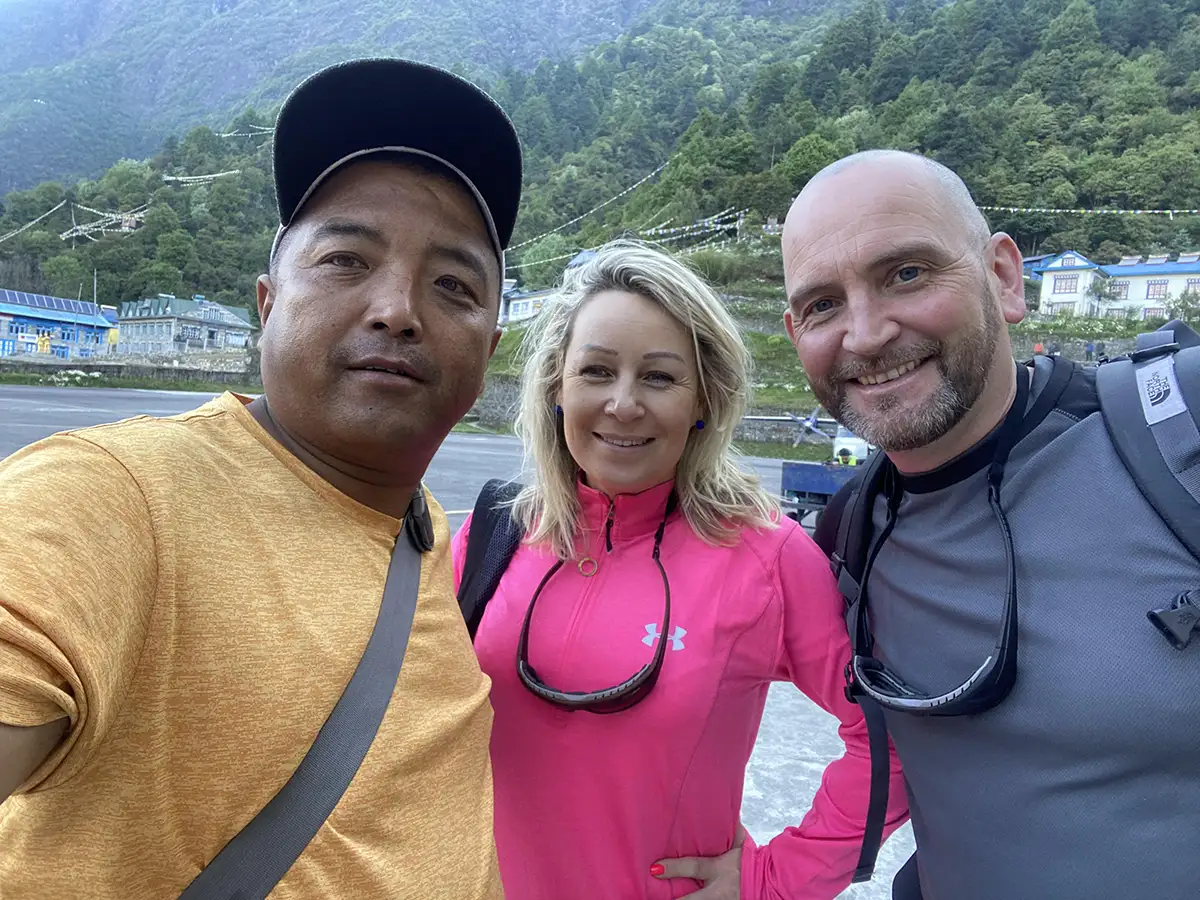
After landing at Lukla, take the main road to Everest Base Camp and pass Phakding (2,650 m/8,694 ft) and Namche Bazar (3,440 m/11,286 ft). You will alternate climbs through Dole (4,200 m/13,779 ft) and Machermo (4,470 m/14,665 ft), finally reaching Lake Gokyo (4,790 m/15,715 ft).
The trek in Gokyo Valley is complete when you hike to the viewpoint of Gokyo Ri (5,357 meters/17,575 feet). Enjoy breathtaking views of the Himalayas from Gokyo Rita and the valley below. Soak in the peaceful atmosphere and retrace your steps along the same route back to Lukla for the flight to Kathmandu.
2. Kathmandu to Lukla via Helicopter Flight and Trek to Gokyo Ri
A helicopter ride from Kathmandu to Lukla is another quick way of getting to the place where the Gokyo Valley Trek begins. Even though it is pricier compared to placing an order for an airplane ticket, you can get more benefits from taking this mode: the change will be faster, and scenery changes more noticeably – starting from deep valleys and hills and ending up with Himalayan would-be glaciers.
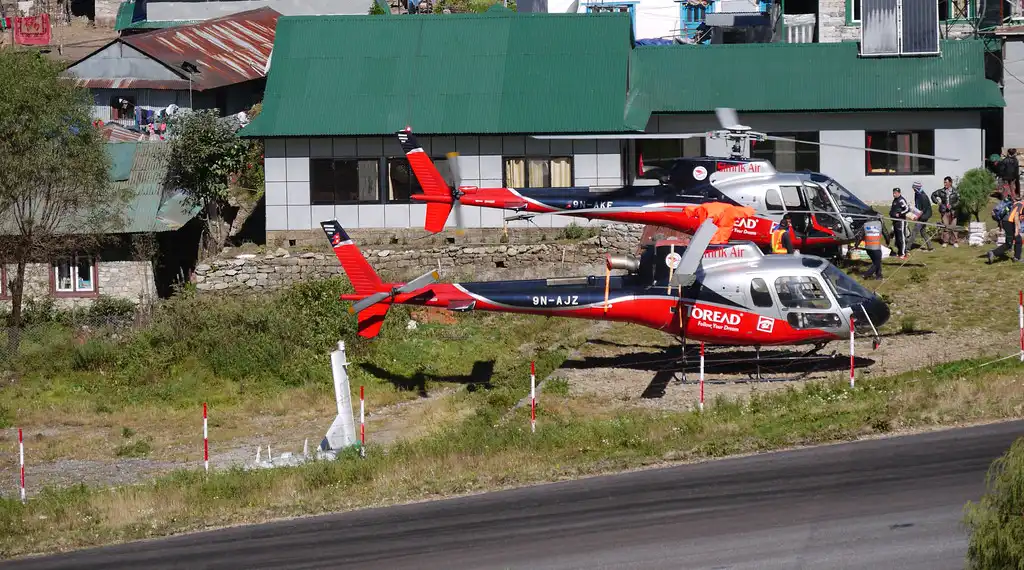
This helicopter flight offers an intimate travel experience and flexibility in your itinerary plans. After landing in Lukla, follow the same trekking route through Phakding, Namche Bazaar, Dole, Macchermo, Gokyo, and finally, Gokyo Ri to complete the excursion.
Those who want to avoid the return trek can opt for a helicopter flight from Gokyo to Lukla or even directly back to Kathmandu. This exclusive option is perfect for trekkers seeking a more comfortable experience. The helicopter flight stands out as a premium choice for those prioritizing convenience and an extraordinary travel experience.
3. Drive from Kathmandu to Jiri and Trek to Gokyo Ri
If you’d like to skip flights to Lukla, you can opt for land transportation. Drive from Kathmandu to Jiri (1,905 meters/6,250 feet), the trekking route in the Everest region, starting with an 8-9 hour drive.
This traditional trek from Jiri to the Everest base camp area requires several days of trekking to reach Namche Bazaar. From Jiri, take the ascending route, Deurali (2,250 m/7,381 ft), Sete (2,575 m/8,448 ft), Junbesi (2,680 m/8,792 ft), Nunthala (2,220 m/7,283 ft), Buspa (2,360 feet), and (7,742 m/ft), Puiyan (2,796 m/9,173 ft) and reach Fakding.
Take the same promenade from Phakding to Namche Bazaar, then cross Dole and Machermo to Gokyo Lake and Gokyo Ri. At the end of the trek, you have the option to retrace your steps to Jiri or fly from Lukla to Kathmandu. This route offers an immersive and extensive travel experience, allowing you to explore various villages and landscapes along the way.
Getting to Gokyo Lake
Trekking to Gokyo Lake in Nepal’s Khumbu region offers a breathtaking trek through some of the world’s most stunning alpine scenery. Here’s a detailed guide on how to reach Gokyo Lake, considering factors like the best times to visit, travel options, and what to expect along the way.
Best Time to Visit Gokyo Lake
The optimal times to go on the Gokyo Lakes Trek are during the spring (March to May) and autumn (September to November). These seasons provide stable weather conditions, with minimal rain and clear skies that offer excellent visibility of the dramatic Himalayan peaks.
The moderate weather during these months makes trekking more comfortable and safer, reducing the risks associated with high-altitude hiking and cold weather.
Spring (March to May)
Pleasantly warm at lower altitudes while moderately cold in higher elevations—adding vibrant colors to the landscape are wildflowers, including rhododendrons that bloom. For photography, the Himalayan range looks stunning with clear skies above it. Trekking is made less dangerous by safe and usually dry paths.
Autumn (September to November)
Clear, stable weather with temperatures ideal for high-altitude trekking. Autumn provides the best mountain visibility, with little fog or rain to obscure the breathtaking views. Trails are usually dry after the monsoon season, providing firm trekking paths. During these peak seasons, the region becomes popular so that trails can be busy, and teahouses (lodging along the trek) often fill up quickly.
For those short on time or needing more time to undertake the strenuous trek, helicopter tours to Gokyo Lake offer a quicker and less physically demanding option.
You can book these flights from Kathmandu or Namche Bazaar to enjoy a unique aerial perspective of the Himalayas, including Everest. Although costly, helicopter tours offer an excellent alternative for experiencing Gokyo’s beauty without the trek.
Necessary Permits and Documentation
To trek to Gokyo Lake, you’ll need several permits essential for legal and safety reasons:
- Sagarmatha National Park Permit: Required for conservation and maintenance of the park area.
- Trekkers’ Information Management System (TIMS) Card: Ensures trekkers’ safety and regulates the trekking industry.
- Local Area Permit: Issued by the local rural municipality for travelers entering their territory.
Everest Base Camp Trek
Everest Base Camp Trek with Helicopter Return
Luxury Everest Base Camp Trek
Alternatives Trekking Route to Reach Gokyo Ri
As we discussed, several viable options exist for reaching Gokyo Lakes from Kathmandu. If you want to explore these pristine lakes through alternative routes, you have a variety of itinerary options to choose from.
1. Classical Gokyo Ri Trekking Route
The most traditional way to reach Gokyo Lakes is through the 12-day Gokyo Valley Trek. This itinerary follows the standard trekking route to the Gokyo Valley and covers the major highlights of the region.
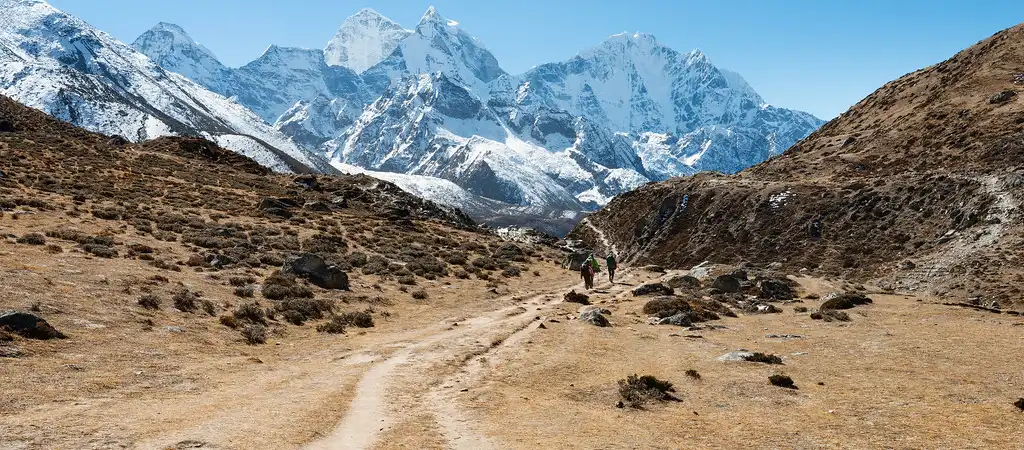
You start with a flight from Kathmandu to Lukla, beginning your trek on the popular Everest Base Camp route, heading towards Namche Bazaar. From Namche Bazaar, you continue along the ascending path toward Gokyo Valley, passing through Dole and Macchermo and eventually reaching Gokyo Lakes. After summiting Gokyo Ri the next day, you return to Lukla via the same route for your flight back to Kathmandu.
2. Everest Base Camp with Gokyo Lake
The Everest Base Camp trek with Lake Gokyo is another spectacular trek starting from Lukla (2,800 meters/9,186 feet). This blended trek will allow you to explore two of the highlights of the Everest region: Everest Base Camp (5,364 meters/17,598 feet) and Lake Gokyo (4,790 meters/15,715 feet).
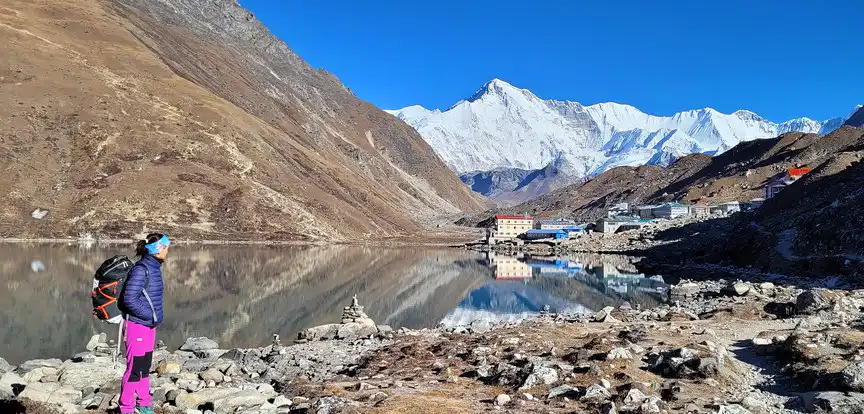
Once you arrive in Lukla, follow the usual route through Phakding (2,650 m/8,694 ft), Namche Bazaar (3,440 m/11,286 ft), Tengboche (3,870 m/12,696 ft), Dingboche (4,410 m/14,468 ft), Lobuche (4,930 m/16,174 ft), and Gorakshep (5,180 m/16,994 ft) to reach Everest Base Camp (5,364 m/17,598 ft).
After a morning hike to Kalapattar (5,545 m/18,192 ft) to see the whole of Everest, head up Zongla (4,800 m/15,748 ft) to the challenging Cho La Pass (5,420 m/17,782 ft). You crossed to Dragnac (4,700 meters/15,419 feet). The route then passes Gokyo Lake (4,790 m/15,715 ft) and Gokyo Ri (5,357 m/17,575 ft). At the end of the trek, you can descend via Dole (4,200m/13,779ft) and Namche Bazaar and return to Lukla.
3. Gokyo Ri Renjo La Pass Trek
Another option from Lukla through the glacial lakes of the Gupta Valley of Everest is the Gokyo Ri Renzo La Das Trek. This itinerary follows the typical Gokyo Valley walking route, leading to Lukla and passing through Fakding Namche market.
You can reach Gokyo Lake by traveling from Namche Bazaar through Dole and Machermo. After walking to Gokyo Ri, descend the Renzo La Pass to Lungden. The route then takes you to Thame Village, Namche Bazaar, and finally, Lukla on your way to Kathmandu.
Gokyo Lakes Trek Detailed Itinerary
Day 1: Arrival in Kathmandu (1,310m)
Our team representatives will greet you at Tribhuvan International Airport. As soon as you check in at the hotel, we’ll be sure to hold a meeting to summarize the trip and make any arrangements that are needed.
You will meet the group that will guide you throughout the Gokyo Lake trek. Enjoy drinks and snacks, submit the required paperwork, and complete the rest of the process.
Day 2: Fly to Lukla (2,860m) and Trek to Phakding (2,610m) – Flight Duration: 35-45 Minutes, Trekking Duration: 3 Hours
We take a 35-45 minute flight from Kathmandu to Lukla, offering majestic mountain views. Upon arrival in Lukla (2,860m), we start our trek to Phakding village. This 3-4 hour trek includes sights of the sacred mountain Khumbila (5,751m) and a walk along the Dudh Koshi river, leading us to Phakding. The village offers several quality lodges, hotels, and guest houses where we’ll stay overnight.
Day 3: Phakding to Namche Bazaar (3,440m) – Trekking Duration: 5-6 Hours
After breakfast, we head towards Namche Bazaar. The trek includes passing through lovely pine forests and crossing a suspension bridge over the glacial Dudh Koshi River. We see mountains like Mt. Nupla (5,885m) and Kongde Ri (6,093m), cross Kusum Khola, and enter Sagarmatha National Park.
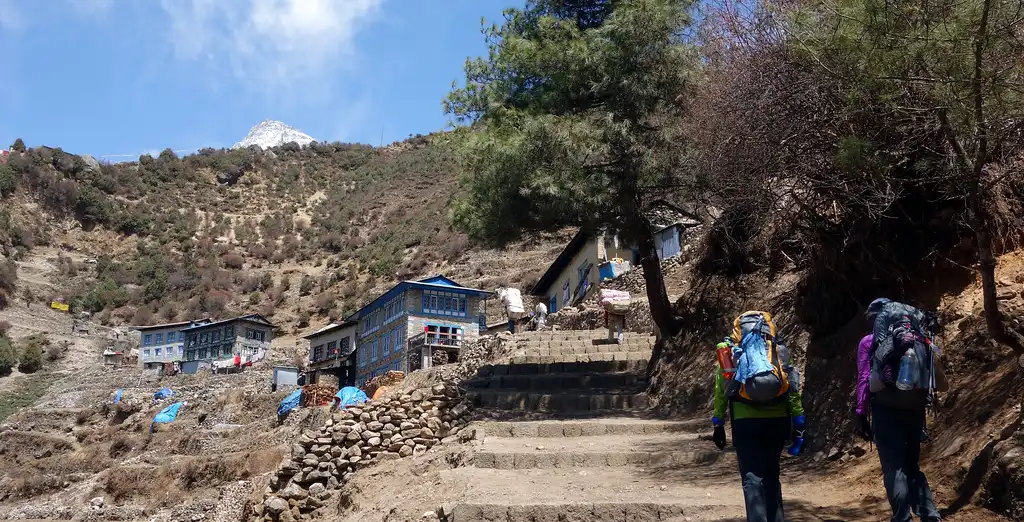
We then ascend to Namche Bazaar, the trade hub for Tibetans and Sherpas. If the weather is clear, we might catch our first glimpse of Mt. Everest. We stay overnight in Namche Bazaar.
Day 4: Acclimatization Day in Namche Bazaar (3,440m)
We spend the day acclimatizing and exploring Namche Bazaar. Options include visiting the local museum, trekking to Syangboche and the Everest View Hotel, and hiking in Sagarmatha National Park for views of Everest, Lhotse, Nuptse, and Ama Dablam. We also enjoy the vibrant market and have tea or coffee in the town.
Day 5: Trek to Dole (4,038m) – Trekking Duration: 5-6 Hours
After a hot breakfast, we climb stony staircases and trek flat trails for two hours to reach Sanasa.
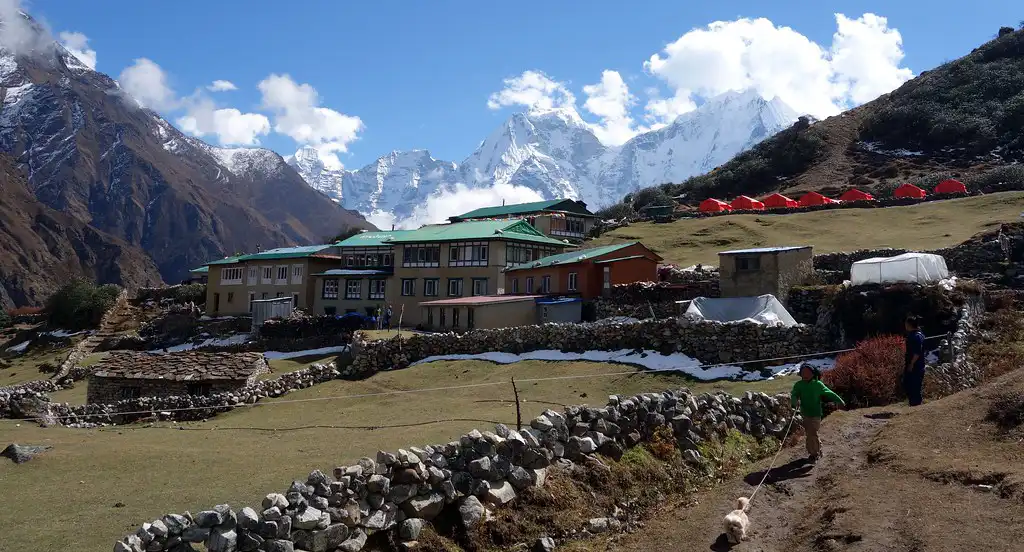
we take a right ascending trail toward Mong La Danda, avoiding the path to Everest Base Camp. This section of the trail sees less traffic and offers closer mountain views.
Day 6: Trek from Dole to Machhermo (4,470m) – Trekking Duration: 5-6 Hours
We ascend to Machhermo through a wide valley with views of Kangtega, Thamserku, and Kusum Kanguru. The trek takes about 5-6 hours. Machhermo has excellent lodges and a hospital where trekkers can learn about altitude sickness.
Day 7: Machhermo to Gokyo (4,790m) – Trekking Duration: 5-6 Hours
The trail ascends a ridge with views of Kanga and Cho-Oyu. We pass through Panka village and cross Ngozumpa Glacier to reach the first and second Gokyo Lakes. We continue to Gokyo (4,790m), where we spend the night.
Day 8: Gokyo to Gokyo Ri (5,357m) to Dole (4,038m) – Trekking Duration: 7-8 Hours
We start at 3 am for the trek to Gokyo Ri, taking a camera and a bottle of hot water. The climb to Gokyo Ri takes about 2-3 hours and, at sunrise, offers a 360-degree view of Everest and the surrounding mountains. After having breakfast at the hotel, we walk back to Dole, which takes about 5 hours.
Day 9: Trek back to Namche Bazaar (3,440m) – Trekking Duration: 4-5 Hours
We have breakfast at the lodge and descend to Mong La Danda, enjoying mountain views. After a tea break, we continue descending to Namche, meeting many trekkers from Everest Base Camp. We celebrate our return from the Gokyo Ri Trek and stay overnight in Namche Bazaar.
Day 10: Return to Lukla (2,860m) – Trekking Duration: 6-7 Hours
We trek back to Lukla, following a scenic, downward trail alongside the Dudh Koshi River and sacred Mani walls. It marks our last day in the mountains. After reaching Lukla, we celebrate and relax for the night.
Day 11: Fly from Lukla (2,860m) to Kathmandu (1,310m) – Flight Duration: 35-45 Minutes
We take a scenic flight back to Kathmandu, reminiscing about the trek. Upon arrival, we relax and cherish the memories of the Gokyo Lakes Trek.
Day 12: Full Day Kathmandu Valley Sightseeing (1,310m)
We explore the rich culture and markets of Kathmandu Valley. Visit UNESCO sites like Pashupatinath, Swayambhunath, and Durbar Square, or wander around Thamel and New Road.
Day 13: Departure from Kathmandu (1,310m)
It’s time to bid farewell to Nepal. After breakfast and some last-minute souvenir shopping, a representative will escort you to the airport. Please make sure you arrive two hours before your departure time.
Exploring Gokyo Lake
The Gokyo Ri trek stands out as a key highlight of the Gokyo Lakes Trek, holding immense significance for trekkers. As one of the premier vantage points in the Everest region, Gokyo Ri provides unmatched views of the surrounding Himalayan peaks.
Many adventurers consider this trek the pinnacle of their trek, seeking both physical challenge and natural beauty. With an impressive Gokyo Ri altitude of 5,357 meters, this spot offers spectacular panoramic views.
From the summit, trekkers enjoy a 360-degree vista of some of the world’s highest mountains, including Everest, Lhotse, Makalu, and Cho Oyu. The towering peaks, combined with the turquoise Gokyo Lakes below, create a truly unforgettable landscape. The early morning hike to witness the sunrise over the Himalayas is especially popular, providing a magical experience as the first light illuminates the majestic peaks.
Gokyo Lakes and Surroundings
Detailed Guide to the Five Sacred Lakes
The Gokyo Lakes, located in the Gokyo Valley, comprise five pristine glacial lakes, each with its unique charm against the towering Himalayas. The Gokyo Lakes Trek map highlights these lakes, starting with the first lake, Longponga Tsho, at an altitude of 4,690 meters.
The second lake, Taujung Tsho, and the third lake, Dudh Pokhari, also offer stunning views, with Dudh Pokhari being the largest and often reflecting the majestic peaks. The fifth lakes, Thonak Tsho and Ngozumpa Tsho, are less frequented, providing a serene setting for those seeking solitude.
Highlights and Must-See Spots
One of the standout spots is the third lake, Dudh Pokhari, with its striking turquoise waters. Many trekkers follow the Gokyo Lakes Trek map to visit this lake. Near these lakes, the Ngozumpa Glacier, one of the Himalayas’ largest glaciers, is another major highlight.
Although the Kathmandu to Gokyo Lake distance is about 140 kilometers as the crow flies, the trek involves a mix of flights and trekking. Along the way, trekkers can explore local Sherpa villages, offering a glimpse into the region’s unique culture and traditions. The Gokyo Lakes in Nepal blend natural beauty with cultural richness, making them a top destination for trekkers.
Packing List
Essential Gear
- Backpack: Choose a durable and comfortable backpack (30-40 liters) with a supportive waist strap.
- Daypack: Bring a small daypack (15-20 liters) to carry essentials on side trips.
- Trekking Poles: Use trekking poles to provide stability and reduce knee strain during long descents and ascents.
- Water Bottles: Carry at least two 1-liter bottles or a 2-liter hydration bladder to stay hydrated.
- Water Purification: Pack tablets, a filter, or a UV purifier to ensure safe drinking water.
- First Aid Kit: Include essentials like bandages, antiseptic wipes, blister treatment, pain relievers, and any personal medications.
- Headlamp: Use a reliable headlamp with extra batteries for early morning or late evening hikes.
Clothing and Equipment
- Thermal Underwear: Wear moisture-wicking and quick-drying tops and bottoms to stay warm and dry.
- T-shirts: Pack lightweight, moisture-wicking t-shirts for daytime hiking.
- Fleece Jacket: Bring an insulating fleece for warmth during cooler parts of the day.
- Insulated Jacket: Carry a down or synthetic insulated jacket for evenings and high-altitude areas.
- Waterproof Jacket: Wear a breathable, waterproof jacket to protect against rain and wind.
- Waterproof Pants: Pack lightweight, waterproof pants for wet weather conditions.
- Trekking Pants: Choose lightweight, quick-drying pants for daytime trekking.
- Thermal Leggings: Use thermal leggings for extra warmth during cold nights.
- Trekking Boots: Wear high-quality, waterproof trekking boots with good ankle support.
- Trekking Socks: Pack several pairs of moisture-wicking, quick-drying trekking socks.
- Gaiters: Use gaiters to keep dirt and water out of your boots.
Accessories
- Hat: Bring a wide-brimmed hat for sun protection during the day.
- Beanie: Pack a warm beanie for cold mornings and evenings.
- Gloves: Wear insulated gloves for warmth and lighter gloves for daytime hiking.
- Buff or Scarf: Use a buff or scarf for neck warmth and to protect against dust and wind.
Additional Gear
- Sunglasses: Use UV-protection sunglasses to shield your eyes from the intense sun at high altitudes.
- Sunscreen and Lip Balm: Pack high SPF sunscreen and lip balm to protect against sunburn.
- Camera: Bring a camera to capture stunning landscapes and memorable moments.
- Snacks: Carry high-energy snacks like nuts, dried fruits, and energy bars for quick boosts.
Accommodation and Food
You will find various lodges and tea houses along the Gokyo Lakes Trek that offer basic but comfortable accommodations. These places usually provide a warm bed, communal dining areas, and simple amenities. Family-run tea houses are common, allowing you to experience local hospitality and culture firsthand.
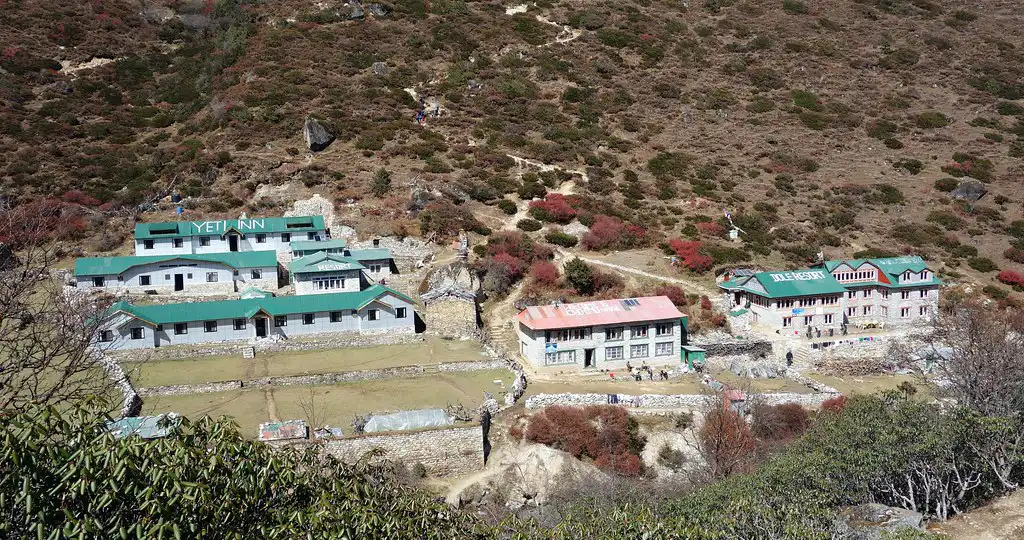
On the trek, you’ll mostly eat traditional Nepali dishes like dal bhat (rice with lentils), noodles, soups, and potatoes. Some places also serve international dishes like pasta and pancakes. To keep your energy up, choose high-calorie, easily digestible foods. Staying hydrated is essential, so drink plenty of boiled or purified water and carry snacks like nuts and energy bars for quick energy boosts.
Health and Safety
Preventing Altitude Sickness
Altitude sickness, or acute mountain sickness (AMS), poses a significant risk during the Gokyo Lakes Trek. To prevent it, follow these detailed guidelines:
Acclimatize Properly: Ascend gradually to avoid altitude sickness. Spend extra days at intermediate altitudes like Namche Bazaar (3,440m) and Machhermo (4,470m) to allow your body to adjust. Use the “climb high, sleep low” principle: ascend to higher altitudes during the day but return to a lower elevation to sleep. This method helps your body acclimatize more effectively.
Stay Hydrated: To stay hydrated, drink 3-4 liters of water a day. Avoid alcohol, caffeine, and smoking, as they can dehydrate you and interfere with your performance. Dehydration can aggravate superficial disease, so it’s important to increase your water intake.
Eat a Balanced Diet: Eat high-carbohydrate meals at high altitudes because they are easier to digest and provide necessary energy. Include foods like pasta, rice, and bread in your diet. Eating small, frequent meals throughout the day helps maintain your energy levels.
Ascend Gradually: Limit your daily ascent to 300-500 meters once you reach altitudes above 3,000 meters. If you need to ascend more, take an extra rest day to acclimatize. Pay attention to how you feel and listen to your body. If you experience AMS symptoms, stop and rest or descend if symptoms persist.
Medications: Diamox (acetazolamide) can help prevent and reduce the severity of AMS. Start taking it one day before ascent and continue for a few days at higher altitudes, but always consult your doctor before taking any medication. Over-the-counter painkillers like ibuprofen can alleviate headaches, a common AMS symptom.
Monitor Symptoms: Recognize the early symptoms of altitude sickness, including headaches, nausea, dizziness, fatigue, and trouble sleeping. If symptoms worsen or you experience severe symptoms such as shortness of breath at rest, confusion, or difficulty walking, get off immediately and seek medical attention.
Emergency Contacts and Resources
Having access to emergency contacts and resources is crucial for your safety on the trek. Here’s a detailed guide:
Local Guides and Trekking Agencies: A knowledgeable guide is invaluable for navigating the trek, communicating with locals, and handling emergencies. Choose a reputable trekking agency that provides experienced guides and support staff. Ensure your guide is trained in first aid and AMS recognition and knows the quickest routes to medical facilities and emergency evacuation points.
Emergency Evacuation Services: Ensure your travel insurance covers high-altitude trekking and emergency evacuation. Providers like Global Rescue and International SOS offer comprehensive plans that include helicopter evacuation, which is the fastest way to reach a hospital in severe cases. Please feel free to go ahead and arrange this if you need to.
Hospitals and Clinics: Familiarize yourself with the locations of medical facilities along the trek. Kunde Hospital, located in the Khumbu region, offers medical services to trekkers and locals. The Himalayan Rescue Association (HRA) clinic in Pheriche specializes in altitude sickness treatment and provides medical care during the peak trekking seasons.
Local Authorities: Keep contact information for local authorities and park officials. The Sagarmatha National Park office and various police and military posts along the trek can assist and coordinate rescue operations in emergencies.
Embassy Contacts: Your country’s embassy in Kathmandu can offer support in severe emergencies, including medical evacuations and legal issues. Keep their contact information handy, as they can be a crucial resource in dire situations.
Conclusion
The Gokyo Lakes Trek offers multiple transportation options from Kathmandu, including flights and treks from Lukla or Jiri, as well as helicopter services for a more comfortable experience. Each route provides unique challenges and breathtaking views, from lush valleys and Sherpa villages to stunning glacial lakes and panoramic vistas from Gokyo Ri.
The Gokyo Lakes Trek provides an unforgettable adventure through Nepal’s majestic landscapes. Whether you choose to trek or fly, the serene beauty of Gokyo Lakes and the thrill of the trek make this a must-do for any trekking enthusiast. Experience the awe-inspiring Himalayan scenery and the rich culture of the Everest region firsthand.

